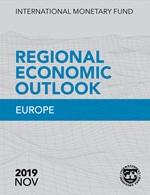Summary available in Czech

Europe
Regional Economic Outlook: Europe
November 2019
Full Text
The European Regional Economic Outlook in the Global Context | Presentation Thomsen
Executive Summary
Economic activity in Europe has slowed on the back of weakness in trade and manufacturing. For most of the region, the slowdown remains externally driven. However, some signs of softer domestic demand have started to appear, especially in investment. Services and domestic consumption have been buoyant so far, but their resilience is tightly linked to labor market conditions, which, despite some easing, remain robust. Expansionary fiscal policy in many countries and looser financial conditions have also supported domestic demand.
On balance, Europe’s growth is projected to decline from 2.3 percent in 2018 to 1.4 percent in 2019. A modest recovery is forecast for 2020, with growth reaching 1.8 percent, as global trade is expected to pick up and some economies recover from past stresses. This projection, broadly unchanged from the April 2019 World Economic Outlook, masks significant differences between advanced and emerging Europe. Growth in advanced Europe has been revised down by 0.1 percentage point to 1.3 percent in 2019, while growth in emerging Europe has been revised up by 0.5 percentage point to 1.8 percent.
- Read more...
Chapter 1: Facing Spillovers from Trade and Manufacturing
Global trade and manufacturing have weakened and so have these sectors in Europe. The evolution of European growth depends on two forces. On the one hand, European exports are softening and prospects for a recovery in global trade are not as strong as they were six months ago. On the other hand, easier financial conditions, expansionary fiscal policy in many countries, and still-strong labor markets are supporting domestic demand. This support is stronger in the newer EU Member States. On balance, near-term growth in Europe is projected to slow from 2.3 percent in 2018 to 1.4 percent in 2019—the lowest growth rate since 2013—and rebound to 1.8 percent in 2020. Amid high uncertainty, risks to the outlook remain to the downside, with a no-deal Brexit the key risk in the near term. Monetary policy should remain accommodative where inflationary pressures are still subdued, which is the case in most European economies. The potential side effects from such policy on financial stability should be carefully monitored. Fiscal policy should continue to be guided by medium-term objectives. But plans for stimulus in case of a sharper downturn should be at the ready, not least because the scope for effective monetary action has diminished. Countries with ample fiscal space should implement fiscal measures that boost potential growth. Reinvigorating structural reforms remains vital to raise subdued potential output growth and address long-term challenges, such as demographics.
Chapter 2: Wage Growth and Inflation in Europe: A Puzzle?
Wages have been rising faster than productivity in many European countries, yet signs of underlying consumer price pressures remain limited. To shed light on this puzzle, Chapter 2 examines the link between wage growth and inflation in Europe and the factors that influence the strength of the passthrough from labor costs to consumer prices. The chapter finds that, historically, wage growth leads to higher inflation, but the impact has weakened since 2009. The passthrough is significantly lower in periods of subdued inflation expectations, greater competitive pressures, and robust corporate profitability. These findings suggest that the recent pickup in wage growth is likely to have a more muted impact on inflation than in the past.



